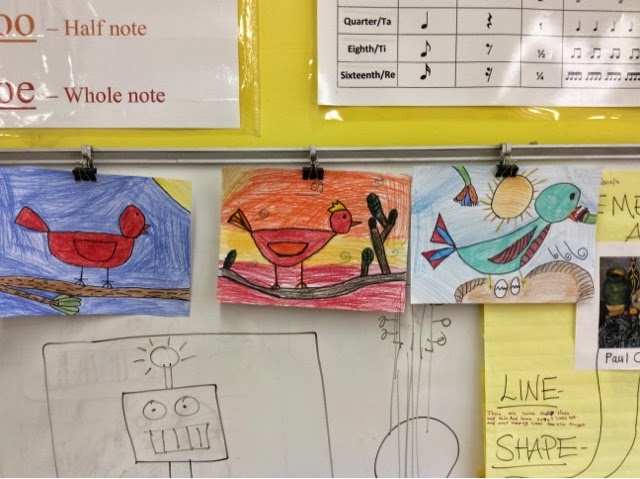3-D Art and problem solving
The art shows are fast approaching--my favorite time of year! The faculty and staff always love seeing so much artwork hanging in the halls, and the students are thrilled to see their work showcased.
I usually do 3-D projects with my students as close to the art show as I can, for storage purposes (translation: "where am I going to store all of these sculptures?"). Right now, there is a lot going on to show you!
Students used problem solving skills to decide which 2-D shapes would be best to draw their animals and which 3-D shapes would correspond to the 2-D shapes in their drawings. So, if a bird has a beak that is a triangle, then what is the 3-D shape to use in a sculpture? There were lots of moments of discovery and amazement! Love witnessing those moments!
Model magic, play-doh, clay...any modeling materials are great for the development of fine motor skills and spatial awareness.
WARNING: this could have probably been about 5 separate blog posts, so bear with me and share my excitement!
Grade 1 bird sculptures:
We drew birds using 2-D shapes, looking at the work of Charley Harper for inspiration (look at his work at www.charleyharperartstudio.com). He uses 2-D shapes in his graphic drawings of animals, which are fun for kids to look at and identify the shapes.
Then it was time to translate the 2-D shapes into 3-D shapes, which in art we call "forms." Using model magic, we made spheres and cylinders as the basis for our bird sculptures. The problem solving energy was flowing--students have been analyzing the footprint of 3-D shapes in math, so this lesson was a great cross-curricular tie-in to support math concepts and apply them in art.
We drew the classic "rainbow fish" from the book by Marcus Pfister, which shows kinders that 2-D shapes are an important element of art. We also used lines to create patterns, like scales. These sculptures were also made with model magic, and we used 3-D shapes, like spheres, to flatten out and make the circle for the fish body. They loved loved loved this project, and did an amazing job on their first sculptures in art class!
Grade 2 Owl Relief Sculptures--beautiful work, and same concepts, using shapes in art, both 2-D and 3-D. We looked at the drawings of Audubon, the famous ornithologist and artist, among others.
Grade 3 clay animals:
Here is an Essential Question for you...why do people in every culture and historical era create art with animals as the subject? We talked about this question in 3rd grade and came up with many answers, all of which pointed to humans' dependence on animals.
We looked at clay camels from Egypt, and talked about how camels tranported people and goods through the desert. We looked at clay plates painted with sea creature motifs from Greece, an island nation that relies on the sea for food. You can view lots of sculptures of animals from world cultures at www.metmuseum.org.
After our discussion, students chose their animal to sculpt. My only rule: the animal must be four legged, to make the sculptures more sturdy. We learned a few basic clay techniques, and used 3-D shapes to sculpt the 2-D shapes used in our sketches. The results are wonderful--sculptures each with their own personality!
And the figures above and masks below, from grades 4 and 5 complete our sculpture projects for the year. Come to see all of the art that students at Village and Bayview have worked so hard on this year at the upcoming art shows!











Comments
Post a Comment